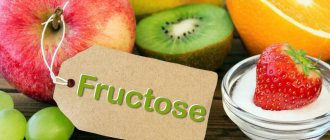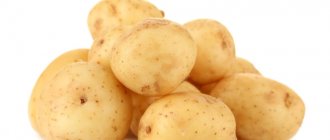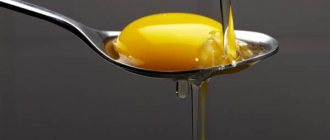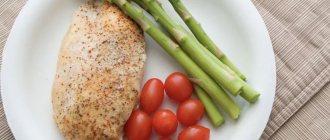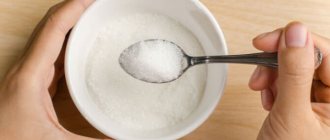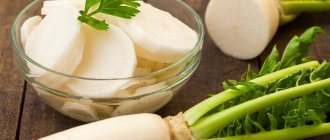The dangers of sugar are well known to everyone who is at all interested in a healthy lifestyle. At the same time, artificial sugar substitutes often cause no less complications than sugar itself. That is why fructose, a natural sweetener made from fruit sugars, is becoming increasingly popular today. Today, the women's website “Beautiful and Successful” will tell its readers whether fructose instead of sugar in the diet brings benefits or harm, and will also introduce the rules for using this product.
What is fructose and how is it obtained?
Few people know that fructose is part of table sugar. The word contributes to the association with fruits, which are extremely beneficial for health. In fact, a monosaccharide can be both beneficial and harmful to the body.
Sucrose consists of equal parts of known monosaccharides. The beneficial physical properties of fructose exceed those of glucose. It is found in fruits, vegetables and all types of honey. It is quickly absorbed and becomes a complete replacement for food refined sugar. Its chemical name is levulose. Chemical formula
Monosaccharide can be obtained using:
- extraction from Jerusalem artichoke tubers;
- hydrolysis using sucrose.
The latter method is used in industrial production. Its volumes have grown significantly in recent decades. This is due to increased demand for the product.
Basic physical properties of fructose:
- crystalline form;
- white;
- highly soluble in water;
- has no smell;
- several times sweeter than glucose.
Products containing glucose: table
| Product | Glucose content in g, per 100 grams |
| honey | 80,4 |
| marmalade | 79,0 |
| dates | 69,0 |
| dried apricots | 66,5 |
| raisin | 66,0 |
| chocolate | 63,0 |
| apples | 7,9 |
| grape | 7,8 |
| beet | 6,7 |
| carrot | 5,7 |
| cherry | 5,4 |
| cherries | 5,4 |
| plum | 3,0 |
| pumpkin | 2,7 |
| watermelon | 2,4 |
| apricots | 2,3 |
| peaches | 2,0 |
| oranges | 2,5 |
The main plant products and sources of glucose are grapes, cherries, cherries, raspberries, strawberries, plums, and watermelon.
Among vegetables, pumpkin, white cabbage and carrots hold the lead in glucose content.
What are the benefits of fructose?
The benefits and harms of fruit levulose are concepts that are completely interrelated. It is a participant in the body’s chemical reactions that occur on the basis of beneficial or harmful properties.
- Promotes energy flow and tones.
- Has the property of stimulating metabolic processes.
- Helps cleanse toxins.
- It has a distinctive property: it does not promote the development of bacteria on teeth and does not cause the development of caries.
- When consumed, it does not increase blood counts.
Fructose – is it harmful for a healthy person?
The presented monosaccharide, like any other substance, also has harmful properties:
- excess leads to excessive formation of lactic acid, which can lead to gout;
- the long-term consequence is the development of hypertension;
- may cause the development of liver pathologies;
- an excessive amount leads to inhibition of the production of leptin, a substance responsible for the feeling of fullness from eating food (this can cause the development of an eating disorder such as bulimia, when a person constantly wants to eat);
- blocking leptin also leads to excessive food consumption, and this is a direct factor in the development of obesity;
- fruit sugar in increased dosages sharply increases the level of “bad” cholesterol in the blood;
- administration for a long period develops a disorder such as insulin resistance, which leads to diabetes, excess weight, and vascular diseases.
Is fructose good for pregnant and lactating women?
Representatives of different theories argue about the benefits and harms of fructose for the body during pregnancy. During the period of bearing a child, it is recommended to reduce the intake of sweets. They talk about replacement if the expectant mother has the following conditions:
- diabetes before pregnancy;
- elevated blood counts;
- one of the stages of obesity.
For a nursing mother, the benefits of fructose as a sugar substitute may be less than the harm if she consumes more than 40 g per day.
Sugar free
People usually stop eating sugar for two reasons: the desire to lose weight or health contraindications.
It’s no secret that sugar is a breeding ground for pathogenic bacteria in the gastrointestinal mucosa, and this causes various inflammatory processes. It increases the level of so-called blood glucose and causes insulin resistance, resulting in type II diabetes mellitus and destroys collagen fibers. Sweet lovers increase blood clotting, which increases the risk of thrombosis. And this is just a small part of the sugar horror stories. It is important to know: sugar does not interfere with the body’s normal functioning if consumed in an amount of no more than 30 g per day. Anything in excess causes a lot of different health problems, which usually manifest themselves after a while.
If the decision to give up sugar has been made, do not rush to become disheartened by the inability to please yourself with your favorite delicacies. At first, the process may seem complicated, but the problem can be solved with the help of sweeteners. Moreover, today stores offer a large selection of natural and artificial sugar substitutes, which, of course, differ in certain characteristics, but they are not difficult to understand.
So, sweeteners are synthetic and natural. Synthetic, or artificial, are obtained from chemical compounds. Natural are of natural origin. Both differ in energy value: artificial ones have a low calorie content or are calorie-free, but can have a negative effect on the body, natural ones come in different calorie contents, but are broken down more slowly than sugar, without causing a sharp release of insulin into the blood.
Synthetic sweeteners are sweeter than sugar. Thanks to this, they can be used in small doses. Natural ones can be either more sweet compared to regular sugar (fructose, stevia) or less (sorbitol, erythritol). For example, stevia and erythritol, being natural, contain no calories at all and do not participate in carbohydrate metabolism. They are not harmful to health, but you still shouldn’t use them thoughtlessly; you don’t eat sugar with spoons either, do you?
Photo by Olga Pak.
Is it possible to give fructose to children?
For children under one year of age, levulose is contraindicated. During this period, they must obtain the necessary carbohydrates from lactose.
After introducing fruits and vegetables into the baby’s diet, fruit sugar comes in its natural form. The benefits of obtaining this element from fruits are much higher than the same intake of sugar. If the body successfully copes with the absorption of carbohydrates, then there is no harm to the child, which often manifests itself as an allergic reaction.
Fructose replacement in children will only be beneficial if there are health risks associated with the onset of symptoms of diabetic conditions.
Is fructose in fruit dangerous?
Fruits on a keto diet are a stumbling block. Some say goodbye to them forever, others cannot imagine summer without watermelons. In fact, it all depends on the source data. If you are not significantly overweight, play sports and are generally active, then an apple (one of the record holders for fructose) will not ruin you. The main thing is to limit yourself to the same apple and not every day.
Those who came to keto with serious visceral obesity, insulin resistance or non-alcoholic hepatosis of the liver should be more careful with fruits.
Fruits are natural candies. Are they natural? It depends what we mean by that. A modern store-bought apple is as different from a wild one as the Jenner-Kardashian sisters were before plastic surgery. They were available only in season, for residents of our region this means late summer - early autumn. This is a great time to eat some fat, which will save you from hunger and cold in winter. Today we are dealing with much sweeter fruits, and the need to make winter stocks has more or less disappeared.
Fructose for diabetes
The benefits of fructose for diabetics are undeniable. It has properties that are important in relieving the symptoms of both types of diabetes. Its main beneficial quality is that it is absorbed without affecting the processes of insulin production.
Fructose has a low glycemic index and is recommended as the main substitute for dietary refined sugar for diabetics. This does not mean that levulose can be consumed uncontrollably.
Information! The maximum allowable intake for diabetics is 35 g.
Daily norm
Fructose is considered to be lower in calories than other carbohydrates. 100 grams of monosaccharide contain 390 calories.
The recommended daily intake of fructose is 40 grams.
Signs of a substance deficiency in the body:
- prostration;
- irritability;
- depression;
- apathy;
- nervous exhaustion.
Symptoms of excess:
- increased appetite;
- excess weight.
Remember, if there is too much fructose in the human body, it is converted into fat and enters the bloodstream in the form of triglycerides. As a result, the risk of developing cardiovascular diseases increases.
The need for fructose increases with active mental and physical activity associated with significant energy consumption, and decreases in the evening/night, during rest, and with excess body weight. The ratio of B: F: Y in a monosaccharide is 0%: 0%: 100%.
However, do not rush to classify the substance as a safe product, since there is a hereditary genetic disease - fructosemia. It indicates defects in enzymes (fructose - 1 - phosphate aldolase, fructokinase) in the human body that break down the compound. As a result, fructose intolerance develops.
Fructosemia is detected in childhood, from the moment fruit and vegetable juices and purees are introduced into the child’s diet.
Symptoms of the disease:
- drowsiness;
- vomit;
- diarrhea;
- pallor of the skin;
- hypophosphatemia;
- aversion to sweet foods;
- lethargy;
- increased sweating;
- liver enlargement;
- hypoglycemia;
- stomach ache;
- malnutrition;
- ascites;
- signs of gout;
- jaundice.
The form of fructosemia depends on the degree of enzyme deficiency in the body. A distinction is made between mild and severe: in the first case, a person can consume the monosaccharide in limited quantities, in the second - not, since when it enters the body it causes acute hypoglycemia and poses a danger to life.
Where is fructose found?
The main sources of the substance are fruits, some vegetables, honey, and berries.
| source, 100 g | volume of fructose contained |
| blackberry berry | 3 g |
| honey, variety of herbs | 39 g |
| sweet and sour apple | 6 g |
| black grapes | 7 g |
| tomato | 1 g |
Recommended reading: Benefits of tomatoes for the body
Content of carbohydrates, glucose, fructose, fiber in products
Carbohydrate content in 100 g of edible portion of food
| Amount of carbohydrates (g) | Food products |
| Very large (65 or more) | Granulated sugar, candy caramel, fondant candies, honey, marmalade, marshmallows, butter cookies, rice, pasta, jam, semolina and pearl barley, dates, raisins, millet, buckwheat and oatmeal, apricots, prunes |
| Large (40-60) | Rye and wheat bread, beans, peas, chocolate, halva, cakes |
| Moderate (11-20) | Sweet curd cheeses, ice cream, white-bran bread, potatoes, green peas, beets, grapes, cherries, cherries, pomegranates, apples, fruit juices |
| Small (5-10) | Zucchini, cabbage, carrots, pumpkin, watermelon, melon, pears, peaches, apricots, plums, oranges, tangerines, strawberries, gooseberries, currants, blueberries, lemonade |
| Very small (2-4.9) | Milk, kefir, sour cream, cottage cheese, cucumbers, radishes, lettuce, green onions, tomatoes, spinach, lemons, cranberries, fresh mushrooms |
Content of glucose, fructose and sucrose in 100 g of the edible part of vegetables, fruits and berries
| Food products | Glucose | Fructose | Sucrose | Food products | Glucose | Fructose | Sucrose |
| (G) | (G) | ||||||
| White cabbage | 2,6 | 1,6 | 0,4 | Plums | 3,0 | 1,7 | 4,8 |
| Potato | 0,6 | 0,1 | 0,6 | Cherries | 5,5 | 4,5 | 0,6 |
| Carrot | 2,5 | 1,0 | 3,5 | Apples | 2,0 | 5,5 | 1,5 |
| cucumbers | 1,3 | 1,1 | 0,1 | Oranges | 2,4 | 2,2 | 3,5 |
| Beet | 0,3 | 0,1 | 8,6 | Tangerines | 2,0 | 1,6 | 4,5 |
| Tomatoes | 1,6 | 1,2 | 0,7 | Grape | 7,8 | 7,7 | 0,5 |
| Watermelon | 2,4 | 4,3 | 2,0 | Strawberry | 2,7 | 2,4 | 1,1 |
| Pumpkin | 2,6 | 0,9 | 0,5 | Cranberry | 2,5 | 1,1 | 0,2 |
| Apricots | 2,2 | 0,8 | 6,0 | Gooseberry | 4,4 | 4,1 | 0,6 |
| Cherries | 5,5 | 4,5 | 0,3 | Raspberries | 3,9 | 3,9 | 0,5 |
| Pears | 1,8 | 5,2 | 2,0 | Black currant | 1,5 | 4,2 | 1,0 |
| Peaches | 2,0 | 1,5 | 6,0 |
Fiber content per 100 g of edible portion of food
| Amount of fiber (g) | Food products |
| Very large (more than 1.5) | Wheat bran, raspberries, beans, nuts, dates, strawberries, apricots, oatmeal, chocolate, raisins, black currants, fresh mushrooms, figs, blueberries, white and red currants, cranberries, gooseberries, prunes |
| Large (1 - 1.5) | Buckwheat, pearl barley, barley, Hercules oatmeal, split peas, potatoes, carrots, white cabbage, green peas, eggplant, sweet pepper, pumpkin, sorrel, quince, oranges, lemons, lingonberries |
| Moderate (0.6-0.9) | Rye bread from sifted flour, millet, green onions, cucumbers, beets, tomatoes, radishes, cauliflower, melon, apricots, pears, peaches, apples, grapes, bananas, tangerines |
| Small (0.3-0.5) | Wheat bread made from second grade flour, rice, wheat cereal, zucchini, lettuce, watermelon, cherries, plums, sweet cherries |
| Very small (0.1—0.2) | 1st grade wheat flour, wheat bread made from 1st and highest grade flour, semolina, pasta, cookies |
Harm of fructose and contraindications
Useful levulose, which is found in fruits and vegetables, has almost no contraindications. A substitute in tablet form can cause significant harm if taken in excess or incorrectly.
- Disturbances in the functioning of the endocrine system. What is a major benefit can become a significant drawback if taken in excess.
- Changes inside the body, formation of fats around the liver or heart if there is an excess.
- Disturbances in the functioning of the liver due to the fact that it is the main organ of processing.
The sugar found in fruits will not benefit people who lack the digestive enzyme that helps digest this type of carbohydrate.
It is not recommended for people with liver disease to avoid stress on the organ.
Levulose tends to cause overeating. The usual volume of sucrose instantly saturates the body, and levulose, due to its slow absorption, helps to increase the dosage to satisfy the need for saturation.
Benefit
Natural monosaccharide can bring undoubted benefits only if used correctly. The daily norm for consumption is up to 45 g. If you follow the norm, you can extract the following beneficial properties of fructose:
- has a lower calorie content compared to sucrose;
- allows you to control body weight;
- can be used as a sweetener by people suffering from diabetes, excess weight or diseases of the endocrine system;
- does not provoke (unlike sugar) the development of caries and other destructive processes of bone tissue;
- gives strength and energy if you engage in high-intensity training or heavy physical labor;
- helps restore body tone and reduce the feeling of fatigue;
- If you consume fructose in the form of fruit, then another beneficial effect, of course, is the intake of fiber into the body, which has a beneficial effect on the digestive tract.
What is the difference between fructose and glucose?
The content of both monosaccharides in equal parts in one carbohydrate makes you think about their similarities and differences.
| index | fructose | glucose |
| processing method | liver cells | universal for all cell types |
| influence on saturation | no instant saturation | prevents the development of hunger |
| influence on hormone production | does not need insulin | helps increase insulin levels |
| effect on blood counts | does not affect | helps to increase performance |
Recently, the theory has become widespread that glucose is the main energy base for the reproduction of cancer cells already present in the body. This is due to the effect of glucose on blood parameters, their sudden changes that are possible upon admission.
According to researchers, fructose in prostate cancer should be the main source of slow energy, which is beneficial when consumed. If you have cancer, it is especially dangerous to use foods that have a high glycemic index. Restricting carbohydrates is by no means the only useful technique in the fight against the development of cancer cells, but it is one of the main ones.
Lack of glucose in the body, symptoms
The causes of hypoglycemia (lack of glucose) can be: prolonged fasting, malnutrition, unhealthy diet, various diseases, and so on.
Signs of glucose deficiency may appear throughout the day.
Often, a person suffering from them may not even be aware of the disorder. For example, feeling tired and exhausted between 11 am and 3 pm is the first symptom of insufficient sugar. The easiest way to detect symptoms is to monitor your body's reactions after eating a sweet donut or coffee.
So, the first symptoms of glucose deficiency:
- weakness, feeling tired,
- shiver,
- sweating,
- headache,
- hunger,
- drowsiness,
- irritation,
- anger,
- confused thoughts,
- vision problems,
- double vision,
- feeling of awkwardness
- frequent heartbeat.
Of the products containing glucose, it is necessary to note grapes, cherries, raspberries, strawberries, plums, watermelon, bananas, pumpkin, white cabbage, carrots, potatoes, grains and cereals, honey.
Which is better: fructose or sugar?
The benefits and harms of fructose and sugar for a healthy person exist simultaneously. This is due to the fact that they belong to the same functional group - carbohydrates.
Levulose can be beneficial due to its slow distribution in the body, but it can be difficult for a person unaccustomed to such actions to refrain from taking it in excess.
The element contained in fruits cannot be harmful and is considered healthier than food refined sugar. It is impossible to overdose on fruit intake. In addition, they contain useful microelements, vitamins and fiber.
Artificial analogues
Aspartame
. One of the most popular sweeteners. It is 200 times sweeter than sugar and has minimal calorie content. It is not often used in the food industry, as it has a significant drawback - it decomposes at high temperatures. This means that it is definitely not suitable for dishes that are subjected to prolonged heating or boiling.
Cyclamate
. It has a pleasant sweet taste, no long aftertaste, it is quite reminiscent of the usual sugar. Does not provoke caries, quickly dissolves in hot liquids and contains no calories. This allows cyclamate to be widely used even in the production of drugs.
Saccharin
. Another bright representative of artificial sweeteners. It can be found not only as an independent sweetener, but also in our usual products. Additive E954 on the soda label marked zero is saccharin.
Sucralose
. Considered one of the safest sweeteners. It contains no calories and does not affect blood sugar levels. Perhaps the most significant advantage of this sweetener is its taste, close to regular sugar. Sucralose completely retains its qualities during cooking (heat treatment and freezing), which means it compares favorably with other artificial sweeteners.
Reasonable consumption of both sweeteners and sugar does not pose a health risk. However, do not forget: losing extra pounds does not mean gaining good health.
